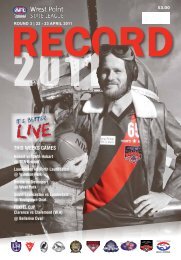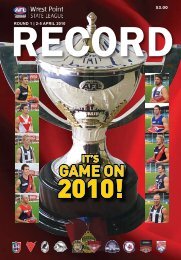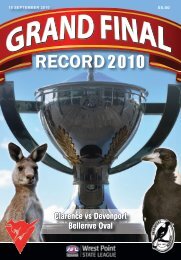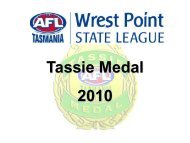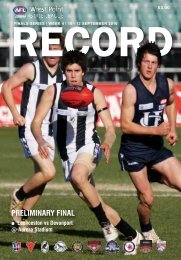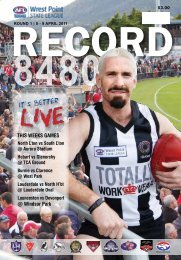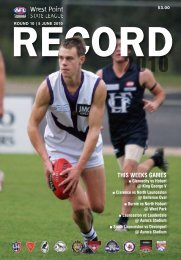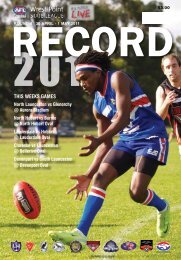March 8, 2011 Longford and Morrie reunited after 43 years ...
March 8, 2011 Longford and Morrie reunited after 43 years ...
March 8, 2011 Longford and Morrie reunited after 43 years ...
You also want an ePaper? Increase the reach of your titles
YUMPU automatically turns print PDFs into web optimized ePapers that Google loves.
<strong>March</strong> 8, <strong>2011</strong> <br />
<strong>Longford</strong> <strong>and</strong> <strong>Morrie</strong> <strong>reunited</strong> <strong>after</strong> <strong>43</strong> <strong>years</strong> <br />
Throughout history there have been some incredible mismatches that defy the odds <strong>and</strong> <br />
somehow combine effectively, despite being so diametrically opposed. <br />
Take Hollywood stars Danny DeVito <strong>and</strong> Arnold Schwarzenegger or comedy legends <br />
Laurel <strong>and</strong> Hardy. <br />
But modern day motoring enthusiasts would be hard pressed to come up with a more <br />
unlikely amalgamation than a Morris Minor <strong>and</strong> motor racing. <br />
Yet despite the initial incomprehensible thought of a “<strong>Morrie</strong>” being thrown around a <br />
race track, fans attending the <strong>Longford</strong> race track in the 1960s witnessed this many <br />
times. <br />
Between 1966 <strong>and</strong> 1968 a Morris Minor, once described by Top Gear presenter Jeremy <br />
Clarkson as Engl<strong>and</strong>'s answer to the Volkswagen Beetle, was wheeled out on to the track <br />
ready to rumble. <br />
This unlikely racer, which became the first British car to sell more than 1,000,000 units <br />
world-‐wide, will reacquaint itself with the famous <strong>Longford</strong> track when the clock is <br />
wound back to the 1960s for the <strong>Longford</strong> Revival Festival <br />
The specific car that thrilled fans then, <strong>and</strong> is now owned by Trevallyn enthusiast, <br />
Andrew Sluce, will be back in action <strong>and</strong> on display for the three day festival from April <br />
1 to 3. The 1959 Morris Minor holds a special place in Andrew’s heart, as well as the <br />
history of the track. <br />
But let’s face it, the car, which looks like it would be more at home in a church car park <br />
than a race track, is not going to grab fastest time in the Flying Mile demonstrations <br />
when you look at the caliber of high-‐powered <strong>and</strong> exotic purpose-‐built race cars that <br />
have been entered. <br />
But “<strong>Morrie</strong>”, as the Morris Minor was affectionately called, has been entered by its <br />
owner for specials reasons other than its colourful racing history throughout Tasmania. <br />
The car was definitely not your archetypical race car, considering that Morris Minor <br />
designers had far more demure usages in mind when the blueprints were penned in the <br />
post-‐World War 2 era. <br />
When the little car debuted at London’s Earl Court Motor Show in September 1948, <br />
Britain’s new economy car was noted more for its thrifty fuel consumption than <br />
performance, a point made even clearer by reading its mechanical specs – engine output <br />
of 21 kW, 53 Nm of torque, powered by an in line side valve 918cc four cylinder motor <br />
which took more than 50 seconds to reach its top speed of 103 kph.
This is hardly the pedigree for a race car but track enthusiasts of the 1950s <strong>and</strong> 1960s <br />
were an imaginative bunch with limited funds <strong>and</strong> an abundance of passion, <br />
characteristics which typify <strong>Longford</strong>’s racing history. <br />
This is a story about the passion that has followed this unlikely racer throughout most of <br />
its 52-‐year life <strong>and</strong> what the car has meant in particular to one of its many owners. <br />
This once ordinary car, which was able to achieve extraordinary things on the race <br />
track, offers a somewhat quirky reflection of <strong>Longford</strong>’s past. It shows that the track <br />
around the Tasmanian town was not just about the motor racing legends such as Sir Jack <br />
Brabham, Jackie Stewart, Graham Hill <strong>and</strong> Stirling Moss, just to name a few of the <br />
international stars of the era that loved racing on this famous track. <br />
Tasmanian John Charlton was the man responsible for creating this unlikely race car. <br />
Having bought the car in 1965, <strong>after</strong> it had changed h<strong>and</strong>s two of three times, he set <br />
about transforming it into a giant killer of more powerful touring cars competing <br />
throughout the state. <br />
A then 18-‐year-‐old John Sluce, who admired all small cars produced by British Motor <br />
Company (BMC), looked on with envy as the modified Morris Minor sat on the <strong>Longford</strong> <br />
grid for the first time in 1966. <br />
A spark had been struck but it wasn’t until John Sluce heard that the car may have been <br />
for sale soon <strong>after</strong> it raced for the last time at <strong>Longford</strong> in 1968, that the seed of a dream <br />
became the start of a long battle to own the vehicle. <br />
After making some inquiries, John Sluce discovered that Charlton did not want to sell, <br />
but the would-‐be owner maintained his desired to own the “<strong>Morrie</strong>” for another 35 <br />
<strong>years</strong> before finally he was able to call himself “custodian” of one of the h<strong>and</strong>ful of <br />
original 1960s touring cars still remaining in Tasmania. <br />
John Sluce’s dream of purchasing the car spanned more than half his life. He frequently <br />
checked on the car which was parked near the silo at the end of Salamanca each time he <br />
visited Hobart in the late 1960s <strong>and</strong> early 70s. <br />
When the car was sold to <strong>Longford</strong> resident Ian “Spider” Johnson, Sluce Snr was <br />
unfortunately not in a position to purchase it. However he <strong>and</strong> son Andy used to often <br />
drive past the carport where the “<strong>Morrie</strong>” was parked on their way to see family <br />
members, just to maintain the link with the car. <br />
Spider eventually sold the car to well-‐known Tasmanian club racing identity Jacque <br />
Sapir <strong>after</strong> 20 <strong>years</strong> of ownership, <strong>and</strong> again John was not able to purchase it. <br />
But four <strong>years</strong> later in 2003, when the car was displayed in Shannon’s Argyle Street <br />
premises, John Sluce approached Jacque about a deal. <br />
An agreement was eventually done, which saw John acquire a half share with Jacque, <br />
Eventually John bought out Jacque <strong>and</strong> a dream that took decades to become a reality <br />
was finally complete. <br />
Andy’s first recollections of the car were as a 12-‐year-‐old. Little did he know 21 <strong>years</strong> <br />
<strong>after</strong> his first sighting, he would inherit the car <strong>after</strong> the premature passing of his father <br />
two <strong>years</strong> ago. <br />
Andy is certain that his father would want to see “<strong>Morrie</strong>” reacquaint itself with the <br />
<strong>Longford</strong> track <strong>and</strong> he has asked John Charlton, the man responsible for establishing the <br />
car in Tasmanian touring car history, to once again drive in the Flying Mile <br />
demonstration. <br />
Not surprisingly, John’s empathy with cars has been a major influence on Andy.
“Growing up around somebody with the reputation <strong>and</strong> admiration from others of his <br />
enthusiasm for cars certainly rubbed off,” Andy said. <br />
“I guess I’m relatively young at 35 to have a love of the historic racing scene but I love <br />
the relaxed old school racing. <br />
“Up until my Dad passed away I suppose I admired the Morris to a degree but I didn’t <br />
have the connection with the car that Dad had. <br />
“I got to know the car a little more <strong>after</strong> Dad passed away when I undertook a few jobs <br />
on it but the pivotal moment came when I typed up as h<strong>and</strong> written note that Dad put <br />
together on the Morris Minor’s story. <br />
The realisation of what the car meant to him really hit home. Now, whenever I spend <br />
time with the car, it just seems to sum up everything about my Dad. <br />
“I feel like I’m the custodian of a small piece of Tasmanian motorsport history. <br />
“He loved the way it remained in original condition, faithful to its race history <strong>and</strong> had <br />
not suffered the same lost history as so many other race cars.”



